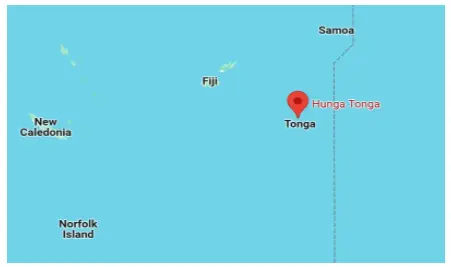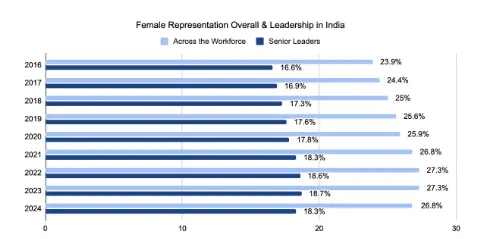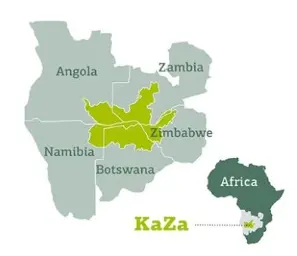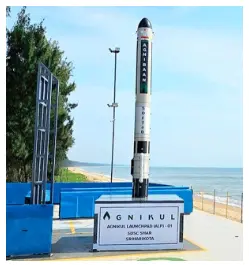Friday, 7th June 2024
Role of Nuclear Technology in Global Food Safety
In News:
- Recently an International Symposium on "Safe Food for a Better Life," organised by the FAO and IAEA, highlighted the crucial role of nuclear technologies in ensuring food safety.
The Application of Nuclear Technology on the Food Safety Standard:
- Complementary to One Health Approach:
- The One Health approach acknowledges the interconnection between human, animal, and environmental health. Nuclear techniques can detect and monitor contaminants, pathogens, and toxins in food and the environment.
- PCR tests, a molecular nuclear technique, can rapidly detect animal diseases in less than a day.
- Food Irradiation:
- Food irradiation involves exposing food to ionising radiation to eliminate harmful bacteria, pathogens, and pests, extending shelf life and ensuring food safety.
- Stable isotope analysis, a nuclear technique, determines the origin and authenticity of food products, detecting adulteration and verifying labelling claims.
- Improved Soil and Water Management:
- Past nuclear fallouts help scientists measure and assess soil erosion. Radioactive nuclides from nuclear events help determine soil health and erosion rates.
- Pest Control:
- Nuclear techniques like the Sterile Insect Technique (SIT) are used for pest control in agriculture, limiting reproduction and reducing the need for chemical pesticides, enhancing food safety.
- Plant Breeding and Genetics:
- Nuclear technology in crop breeding develops enhanced varieties adaptable to climate change. Irradiation of seeds by gamma rays, X-rays, ions, or electron beams initiates genetic alterations, increasing genetic diversity for breeding.

Need for Tech-Related Advancements in Food Security:
- Climate Change: Climate-induced challenges like droughts, floods, and temperature fluctuations negatively impact crop production and food availability, necessitating the promotion of climate-smart agriculture (CSA).
- Food Waste: According to the FAO, about one-third of food produced for human consumption is lost or wasted globally, totaling approximately 1.3 billion tons per year. In 2020, around 3.1 billion people could not afford a healthy diet (FAO, 2022).
- Increasing Population: The global population is projected to reach 9.7 billion by 2050 (UN World Population Prospects, 2019), placing immense pressure on food production systems and necessitating technological advancements.
- Limited Resources: With limited arable land and freshwater resources, technology can maximise productivity through vertical farming, hydroponics, and efficient irrigation systems.
|
Key Initiatives : Global
India Technology demonstration plants were set up for Irradiation:
|
Challenges are Associated with using Nuclear Technology for Food Safety:
- Geographical and Regional Variations:
- Diverse agro-climatic regions and farming practices pose challenges in the uniform application and adaptation of nuclear techniques worldwide.
- Isotopic techniques for soil and water management require region-specific calibration due to variations in soil types, climatic conditions, and irrigation practices.
- Limited Funding and Investment in Technology:
- Developing irradiation facilities for food preservation and pest control requires significant capital investment, often limited by budget constraints.
- Access to advanced techniques like accelerator-based mutation breeding or specialised analytical equipment for food traceability can be hindered by technology transfer restrictions or high costs.
- Regulatory Challenges:
- Using nuclear technology in agriculture involves strict regulations and guidelines for safety and security, making the approval, licensing, and compliance processes lengthy and complex.
- Intellectual property rights and technology transfer barriers further complicate adaptation.
- Lack of Allied Infrastructure:
- The absence of specialised laboratories and research facilities hinders the effective utilisation of nuclear techniques in agriculture.
- A shortage of trained personnel and expertise limits the widespread application of these techniques.
|
Nuclear Technology:
Methods for Harnessing Nuclear Energy:
|
Way Forward:
- Developing Infrastructure and Facilities: Allocate funds and resources to establish irradiation facilities, analytical labs, and equipment for nuclear technology, such as food irradiation facilities to preserve perishable produce, reduce losses, and ensure food safety.
- Regulatory Reforms and Streamlining Processes: Create guidelines for the safe handling, transport, and disposal of radioactive agricultural materials. Establish a regulatory body to oversee the approval and commercialization of radiation-induced mutant crops.
- Promoting Public-Private Partnerships: Foster collaborations between research institutions, the private sector, and industry for nuclear technology transfer. Offer incentives for companies to invest in developing and commercialising nuclear-based agricultural products.
- International Cooperation and Knowledge Sharing: Encourage international collaborations, such as partnering with the Joint FAO/IAEA Centre for expertise and technology transfer.
|
UPSC Civil Services Examination Previous Year’s Question (PYQs) Prelims Prelims – 2019 Q:1 Consider the following statements:
Which of the statements given above is/are correct?
Ans: (c) Mains Mains – 2021 Q:1 What are the present challenges before crop diversification? How do emerging technologies provide an opportunity for crop diversification? |
UNESCO State of Ocean Report 2024
In News
- According to the UNESCO Report 2024 the oceans are crucial for climate regulation, but our understanding is insufficient to address various ocean crises and validate carbon dioxide removal technologies.
- The report aims to monitor the progress of the UN Decade of Ocean Science for Sustainable Development (2021-2030) and to mobilise global action towards achieving a sustainable ocean.
Findings of the Report
Ocean Heat and Warming:
- The upper 2,000 meters of the oceans have warmed at a rate of 0.32 ± 0.03 watts per sq.m. from 1960 through 2023 and are expected to continue warming, leading to irreversible changes.
- About 90% of the Earth’s energy imbalance (the difference between incoming and outgoing energy) is being absorbed by the oceans, resulting in a cumulative increase in ocean heat content (OHC).
- Increased OHC may prevent ocean layers from mixing, lowering the oxygen content of near-surface high-latitude waters reaching deeper layers, a process known as deoxygenation. However, it is still unclear whether deoxygenation is accelerating in response to increased OHC.
- Deoxygenation negatively impacts marine ecosystems and coastal communities reliant on oceans.
Ocean Acidification:
- The report highlights the mean global increase in ocean acidification in all ocean basins and seas.
- Coastal waters can turn acidic due to
- Natural processes (freshwater influx, biological activity, temperature change and ENSO)
- Human activities (nutrient input from agricultural and industrial activities)
Marine Carbon Dioxide Removal (mCDR) Technologies:
- mCDR technologies capture carbon dioxide from the air and store it durably.
- These techniques, such as altering seawater chemistry or adding nutrients to promote plankton growth, face technical, environmental, and regulatory challenges.
- The ocean absorbs around one-quarter of the annual emissions of anthropogenic CO2.
Marine Biodiversity:
- The UN 2030 Agenda for Sustainable Development emphasises marine biodiversity protection for sustainable food security, which aligns with the Kunming-Montreal Global Biodiversity Framework‘s goal of protecting 30% of the ocean by 2030, focusing on conservation and sustainable resource use.
- 50% of all catalogued marine species are reported in Marine Protected Areas (MPA), which occupy only 9% of the ocean. 72% of species facing extinction find refuge in MPAs, with 54% in no-take zones.
|
Case Study: Marine Protected Area (MPA) Success in the Coral Triangle:
- The Coral Triangle is a marine region in Southeast Asia known for its high marine biodiversity.
- Initiative: Establishment and management of a network of Marine Protected Areas (MPAs) in the Coral Triangle to conserve coral reefs, fish populations, and other marine species.
- The MPA network has led to the recovery of coral reefs, increased fish populations, enhanced biodiversity within the protected areas, and benefitted local communities through sustainable practices.
- Key Strategies include collaborative governance involving local communities, government agencies, and conservation organisations, enforcement of fishing regulations, and community engagement.
- The success of the MPA network in the Coral Triangle highlights the importance of community involvement, effective management strategies, and long-term commitment to conservation efforts.
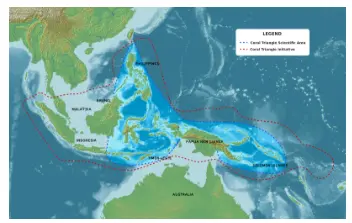
Souce: (DTE)
Demand for Special Category Status
In News:
- The discussion regarding the special category status for Bihar and Andhra Pradesh has regained momentum following the Lok Sabha elections.
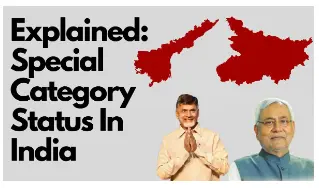
Special Category Status:
- It is a designation provided by the Central government to aid the progress of states encountering geographical or socio-economic challenges.
- The concept originated in 1969 under the recommendation of the fifth Finance Commission (FC), aiming to offer additional assistance to certain states grappling with geographical and infrastructural limitations.
- Factors are considered before granting SCS includes
- hilly and difficult terrain.
- low population density.
- a significant tribal population.
- strategic positioning along international borders.
- economic and infrastructural backwardness, and the non-viability of state finances.
- States Covered:
- In 1969, the SCS was initially granted to three states: Jammu & Kashmir, Assam, and Nagaland.
- Subsequently, eight more states, namely Arunachal Pradesh, Manipur, Meghalaya, Mizoram, Sikkim, Tripura, Himachal Pradesh, and Uttarakhand, were bestowed with the SCS by the former National Development Council.
Why is Bihar Demanding Special Category Status (SCS)?
- Bihar contends with significant economic challenges, like lack of industrial development and limited investment opportunities. The state's partition led to industrial migration to Jharkhand, exacerbating unemployment and impeding economic progress.
- Bihar frequently confronts natural disasters such as floods in the north and severe droughts in the south. These calamities disrupt agricultural activities, impacting livelihoods and economic stability.
- Infrastructure deficiencies persist, particularly in irrigation facilities and water supply. Insufficient irrigation resources hamper agricultural productivity, a critical livelihood source for many.
- Bihar has a high poverty rate, With a per-capita GDP of around Rs 54,000, Bihar has consistently been one of the poorest States. BIhar is home to around 94 lakh poor families and the granting of SCS will help the government get about RS 2.5 lakh crore required to fund various welfare measures over the next five years.
- It is estimated that SCS designation could provide approximately Rs 2.5 lakh crore over the next five years, facilitating the implementation of various welfare measures.
Why is Andhra Pradesh Demanding SCS?
- When Andhra Pradesh was bifurcated to create Telangana in 2014 through the AP Reorganisation Act, the union government promised Special Category Status (SCS) to AP to compensate for the loss of revenue and Hyderabad, where much development was concentrated.
- AP inherited 59% of the undivided state’s population, debt, and liabilities but only 47% of the revenue.
- The SCS would get higher grants-in-aid from the Centre, and such states enjoy special incentives such as Income-tax exemptions, GST concessions, Customs duty waivers, etc.
- In SCS states, the Centre funds central schemes up to 90%, compared to 70% in non-SCS states.
- AP argues that SCS is vital for the state’s rapid industrialisation, employment generation, and overall development, and it would encourage investments in sectors like healthcare, manufacturing, IT, etc.
Benefits of Special Category Status (SCS):
- Historically, SCS states received approximately 30% of central assistance, determined by the Gadgil-Mukherjee formula.
- Increased Devolution of Funds: With the recommendations of the 14th and 15th Finance Commissions (FC) and the dissolution of the Planning Commission, this assistance has been merged into an enhanced devolution of the divisible pool funds for all states, increasing to 41% in the 15th FC from 32%.
- Higher Funding in Centrally-Sponsored Schemes: The Centre provides 90% of the funds required in a Centrally-Sponsored Scheme to special category status states, compared to 60% or 75% for other states. The remaining funds are contributed by the state governments.
- Carry Forward of Unspent Funds: Unspent money in a financial year does not lapse for SCS states; it is carried forward, providing flexibility in utilising allocated funds for developmental projects.
- Concessions in Taxes: SCS states receive significant concessions in excise and customs duties, income tax, and corporate tax, promoting industrial and economic growth within these regions.
- Higher Share of Centre’s Budget: Approximately 30% of the Centre’s Gross Budget is allocated to Special Category states, ensuring a substantial portion of resources for their development needs.
The Concerns Related to Special Category Status:
- Resource Allocation: Granting Special Category Status (SCS) involves providing additional financial assistance to the state, which can strain the central government's resources. Balancing the allocation of funds among various states becomes crucial, and granting SCS might lead to disparities or dissatisfaction among non-SCS states.
- Dependency on Central Assistance: States bestowed with SCS often become heavily reliant on central assistance. This could potentially discourage efforts toward self-sufficiency and independent economic growth strategies as they may become complacent in seeking external support.
- Implementation Challenges: Even after receiving the SCS designation, there might be challenges in effectively utilising the allocated funds due to administrative inefficiencies, corruption, or lack of proper planning. .
Way forward:
- As India marches towards achieving a $5 trillion economy, the ongoing debate surrounding Special Category Status (SCS) highlights the necessity for a nuanced approach to development.
- The insights gleaned from the SCS experience can serve as valuable lessons informing future strategies aimed at mitigating disparities and fostering a more balanced development trajectory nationwide.
- It is crucial that the principles of cooperative federalism steer the discourse on SCS, guaranteeing that every region of India has the opportunity to partake in the benefits of economic advancement.
Source: TH
ONDC Records Transactions
In News:
- In May 2024, the Open Network for Digital Commerce (ONDC) achieved a significant milestone by recording an all-time high of 8.9 million transactions across retail and ride-hailing segments.
- The Open Network for Digital Commerce (ONDC) has expanded its reach to encompass 5,35,000 sellers across more than 1,200 cities, with a remarkable 84 percent being small sellers.
- Impressively, these small-scale entrepreneurs contribute 56 percent of the total orders, demonstrating ONDC's commitment to empowering and benefiting small businesses.
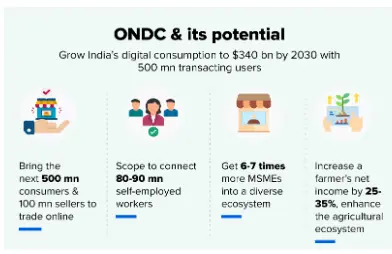
About ONDC:
- The Open Network for Digital Commerce (ONDC) is an initiative aimed at fostering open networks for the exchange of goods and services over digital or electronic platforms.
- It operates on open-sourced methodology, utilising open specifications and network protocols that are platform-independent.
- ONDC is spearheaded by the Department for Promotion of Industry and Internal Trade (DPIIT) under the Ministry of Commerce and Industry.
Need of the ONDC
- India's E-commerce Landscape: Despite having the third-largest online shopper base globally, India's e-retail penetration remains relatively low at 4.3%, compared to 25% in China and 26% in South Korea. There is a significant gap between the potential and the current state of e-commerce adoption in India.
- Platform-centric Challenges: The dominance of single entities in managing all operations within the e-commerce value chain poses challenges. Sellers often face high margin costs and the need to maintain a presence across multiple platforms, limiting their flexibility and profitability.
- Limited Interoperability: Currently, buyers and sellers can only transact if they are part of the same platform, restricting the scope of commerce and reducing market efficiency.
- Rise of Monopolies: The emergence of monopolistic practices in the e-commerce sector creates barriers to entry for new players, hindering widespread adoption and stifling competition. This trend undermines the principles of a fair and open market.
Features of ONDC:
- Autonomous Transactions: ONDC empowers consumers and merchants to engage in transactions for goods and services without being restricted to a particular platform or application.
- Improving Effectiveness: ONDC strives to enhance effectiveness by deploying a dynamic pricing mechanism, digitised inventory management, and optimising delivery expenses. This contributes to reducing the overall operational expenses for all stakeholders involved.
- Localised Search Engine: ONDC introduces a hyper-localised search engine that utilises GPS proximity data as its default setting. This enables buyers to independently select sellers and logistics partners to fulfil their orders based on proximity.
- Legal Compliance: The platform is designed to comply with the Information Technology Act, 2000, and is structured to adhere to the forthcoming Personal Data Protection Bill, ensuring regulatory alignment and data security standards.
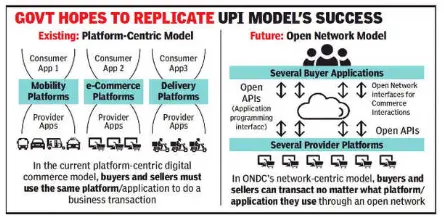
Benefits of ONDC:
- Sellers: Enable fair competition with larger players and increase online visibility.
- Buyers: Enjoy seamless shopping experiences with access to a diverse product range through a single checkout process.
- Tech Companies: Experience accelerated product/service adoption and scalability.
- FinTech: Provide credit and financing options to e-commerce entities, fostering financial inclusion and growth.
Challenges:
- Complexity Factor: ONDC's intricate mechanisms make it less user-friendly compared to simpler systems like UPI, hindering easy adoption.
- Breaking Established Habits: Consumers are used to current e-commerce platforms, so ONDC must provide a seamless, user-friendly experience to compete.
- Dispute Resolution Concerns: ONDC's focus on buying and selling, without managing the entire transaction lifecycle, could increase disputes over deliveries, product quality, and after-sales service.
- Lack of Robust Grievance Redressal: Unclear responsibility for customer service and complaint handling may deter users from joining ONDC.
- Challenges from Existing Platforms: E-commerce giants have strong customer relationships through loyalty programs and bundled services, requiring ONDC to develop strong strategies to attract and retain customers.
- Price Advantage Uncertainty: As a facilitator, ONDC may struggle to influence product pricing or offer discounts like established players who benefit from bulk deals and partnerships.
|
UPSC Civil Services Examination, Previous Year Question (PYQ) Prelims— 2017 Q:1 With reference to ‘Quality Council of India (QCI)’, consider the following statements:
Which of the above statements is/are correct?
Ans –C Prelims– 2022 Q:2 Consider the following:
Which of the above are built on top of open-source digital platforms?
Ans: (d) |
Source: TOI
Direct Seeded Rice Method
In News:
- Recently, the Indian Council of Agricultural Research (ICAR) has introduced herbicide-tolerant (Ht) basmati rice varieties, aimed at enhancing weed management in rice cultivation and enabling water-conservation methods such as direct seeded rice (DSR).

Direct-Seeding Method:
- Direct-Seeded Rice (DSR), commonly referred to as the 'broadcasting seed technique,' is an eco-friendly approach to sowing paddy that conserves water.
- In this method, seeds are directly planted into the fields, bypassing the necessity for nursery preparation and transplantation.
- It is a traditional method of cultivating Basmati rice in the North Western Plains, including Punjab and Haryana.
|
DSR Innovations:
DSR Adoption and Impact:
|
Benefits of Direct Seeded Rice (DSR):
- Labor Reduction: Employing drum seeders reduces the labour requirement for sowing seeds on one acre to only two labourers, a significant reduction from the 25-30 labourers needed in traditional methods. This effectively cuts labour expenses and lightens the workload for farmers.
- Herbicide-Tolerant Basmati Rice:ICAR has introduced commercially available non-genetically modified (non-GM) herbicide-tolerant (Ht) basmati rice varieties. These varieties allow for the direct application of the herbicide Imazethapyr, facilitated by a mutated ALS gene.
- Time and Resource Efficiency: By eliminating the need for nursery cultivation, farmers save approximately 30 days in the crop cycle. This enables them to start the rabi season earlier and avoid untimely rains during the harvesting phase.
- Efficient & Yield-boosting: Scientific debate suggests that hand weeding at designated intervals (20 and 40 days after sowing) in Direct-Sown Rice (DSR) is more efficient and yield-boosting than employing Imazethapyr.
- Yield Enhancement: Based on research trials and field surveys among farmers, this technique has resulted in a yield increase of one to two quintals per acre compared to puddled transplanted rice.
- Conservation of Water: The direct-seeding method reduces water demands by approximately 15%, as water logging occurs only after a month. This is particularly advantageous in regions experiencing delayed rainfall.
- Reduced Methane Emissions: A shorter flooding period and reduced soil disturbance compared to transplanting rice seedlings help reduce methane emissions
Challenges Associated With Direct Seeded Rice (DSR):
- Yield and Pest Susceptibility Concerns: Farmers express apprehensions about Direct Seeded Rice (DSR) due to perceived lower crop yields compared to traditional transplanting methods. They increased susceptibility to pests and insects in DSR crops as another challenge.
- Weed Diversity and Concerns: While Imazethapyr selectively targets certain broadleaf weeds (BLW), not all weed varieties are affected. The emergence of herbicide-resistant weeds poses risks to rice production and food security.
- Post-Harvest Facility Shortage: Inadequate post-harvest facilities pose a barrier to the widespread adoption of Direct Seeded Rice (DSR). Enhanced facilities are essential to efficiently handle and process DSR crops, facilitating their integration into the market.
- Climate Extremes: Extreme temperatures and insufficient rainfall may impact seed germination and crop growth, posing challenges to the successful cultivation of DSR crops. Adaptation strategies and resilient crop varieties are necessary to mitigate the effects of climate extremes on DSR production.
|
UPSC Civil Services Examination Previous Year Question (PYQ) Prelims – 2020 Q:1 What is/are the advantages/advantages of zero tillage in agriculture?
Select the correct answer using the code given below:
Ans: (d) Prelims - 2018 Q:2 With reference to the Genetically Modified mustard (GM mustard) developed in India, consider the following statements:
Which of the statements given above is/are correct?
Ans: (b) |
Source: DTE
Preston Curve
In News:
- Recently seen in the news the preston curve refers to a certain empirical relationship that is witnessed between life expectancy and per capita income in a country.
About Preston curve:
- The Preston curve refers to the empirical relationship between life expectancy and per capita income in a country, proposed by American sociologist Samuel H. Preston in 1975.
- It refers to a certain empirical relationship that is witnessed between life expectancy and per capita income in a country.
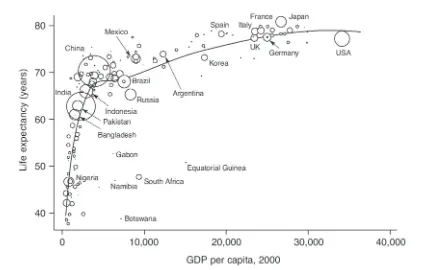
Preston curve
Key Points of preston curve:
- Relationship Between Wealth and Lifespan: The curve illustrates that individuals in wealthier countries generally enjoy longer life spans compared to those in poorer countries, likely due to better access to healthcare, education, nutrition, and other essential services.
- Initial Impact of Income Increase: As a poor country's per capita income rises, its life expectancy initially increases significantly. For example, India's per capita income rose from Rs 9,000 in 1947 to Rs 55,000 in 2011, while life expectancy increased from 32 to 66 years.
- Diminishing Returns: However, the positive relationship between per capita income and life expectancy begins to flatten beyond a certain point, as the human lifespan cannot be increased indefinitely.
- Applicability to Other Indicators: The positive relationship depicted by the Preston curve can also be applied to other development indicators such as infant/maternal mortality, education, and healthcare, reflecting broader improvements in quality of life with increased income.
Pneumothorax
In News:
- NEET UG 2024 Topper suffered from pneumothorax, a severe lung condition.

- A pneumothorax is a lung rupture because of a puncture. It is when air gets inside the chest cavity and creates pressure against the lung, causing it to collapse partially or fully.
- It happens when there’s air in the space between the chest wall and the lung (pleural space).
- Causes: Lung injury, smoking, lung diseases.
- Symptoms: Slight chest pain and breathlessness. But in extreme emergencies, one may present with profound breathlessness and a dangerous fall in oxygen levels.
Source: (IE)
Cassowary
In News:
- Recently, the southern cassowary is facing the risk of extinction in Australia.
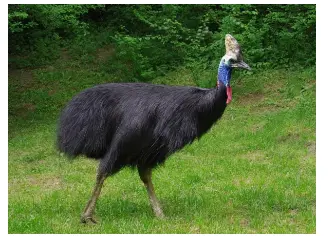
Cassowary
- Cassowaries belong to a group of flightless birds known as ratites, which also includes the ostrich, emu, moa (now extinct), and the small kiwi.
- They are among the closest living species to dinosaurs.
- There are three extant (living) species of cassowary:
- Southern (Casuarius casuarius)
- Northern (C. unappendiculatus)
- Dwarf (C. bennetti)
- Largest Forest Bird: The southern cassowary is the largest forest bird in the world and the second heaviest bird after the ostrich. It is the third tallest, following the ostrich and emu.
- Distribution: Found in Northern Australia, New Guinea, and surrounding islands.
- Habitat: They inhabit tropical forests and wetlands.
- Physical Appearance: Adults have black plumage, while immature birds are brownish. They have a naked blue head protected by a bony helmet or casque.
- Diet: Primarily frugivorous, feeding on fallen fruits, but also predates on small vertebrates when available.
- Conservation Status: Classified as Least Concern for all three subspecies.
- Threats: Face threats from car strikes, habitat clearing, dog attacks, and climate change.
- Ecological Role: Considered a “keystone species” due to their crucial role in maintaining biodiversity and aiding seed dispersal in the rainforest.
Source:(NDTV)
Mission Karmayogi: Civil Services Capacity Building
Context:
- Recently, the Indian Institute of Public Administration assessed the impact of Mission Karmayogi by soliciting feedback on trained staff. The assessment reported increased proficiency in data analytics and e-governance tools among the personnel.
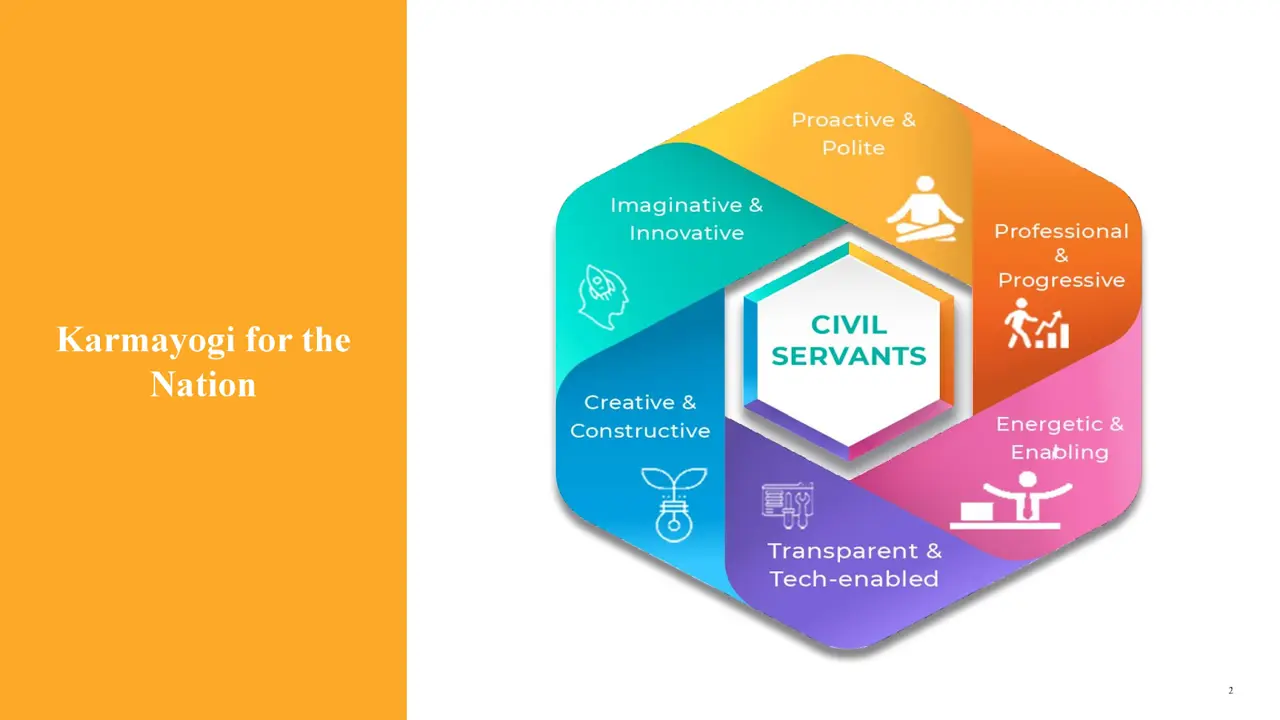
Mission Karmayogi:
- Mission Karmayogi is India's National Programme for Civil Services Capacity Building, launched by the Prime Minister to enhance the efficiency of governance and empower civil servants.
- The mission aims to transform three million civil servants into citizen-centric, future-ready, and result-oriented 'Karmayogis'.
- This initiative is crucial for realising India's vision of becoming a global manufacturing hub, a significant exporter of value-added services, and a major supplier of human skills to the developed world by 2047.
How will it work?
- The capacity building programme will operate through the Integrated Government Online Training (iGOT-Karmayogi) digital platform, offering content sourced from global best practices rooted in Indian national ethos.
- This platform will serve as the cornerstone for the National Programme for Civil Services Capacity Building (NPCSCB), enabling comprehensive reform of capacity building at individual, institutional, and process levels.
- Officers will undergo evaluation based on the courses they undertake throughout their careers to enhance their skills.
- An online database will track their completed courses, performance, areas of expertise, etc.
- This database will facilitate easy access for appointing authorities to review officers' training records when considering vacancies or appointments.
Need for Transformation:
- The historical challenges of delayed infrastructure projects in India, stemming from inter-ministerial permissions and siloed approaches, necessitated transformation.
- The emergence of the PM Gati Shakti platform aimed to address these issues by integrating legal, geographic, and planning layers to facilitate a holistic approach to infrastructure development.
- However, for the platform to succeed, civil servants require expertise in emerging technologies and Geographic Information Systems (GIS).
- India's aspirations to become a global manufacturing hub, a significant exporter of value-added services, and a mass supplier of human skills to developed countries underscore the importance of this transformation.
- With 46 lakh Central government employees at all levels, the civil service needs to evolve to meet the demands of a $30 trillion economy by 2047.
Approach For Mission Karmayogi:
- Capacity Building Commission (CBC): Providing policy guidance and tools to enhance civil servants' capabilities at all levels.
- Collaboration with Institutions: Partnering with institutions like Gati Shakti Vishwavidyalaya and the National Academy of Customs, Indirect Taxes, and Narcotics to curate digital training courses.
- Competence Rooted in Indian Ethos: Fostering a competent civil service grounded in Indian values, with a shared understanding of the country's priorities for effective public service delivery.
- Technology-Enabled Karmayogis: Focusing on making civil servants more creative, constructive, imaginative, and proactive, while promoting transparency and leveraging technology for better governance.
- Content Development: Offering carefully crafted and vetted content from top-notch institutions, universities, private content providers, and individual resources as training modules, either in-house or through knowledge partner
Under Mission Karmayogi, six key pillars form the foundation:
- Policy Framework: Offers strategic direction for capacity-building initiatives.
- Institutional Framework: Establishes the organisational structure to support the program's implementation.
- Competency Framework: Defines the skills and knowledge necessary for effective civil service.
- Digital Learning Framework (iGOT-Karmayogi): Provides a comprehensive online learning platform.
- Electronic Human Resource Management System (e-HRMS): Streamlines personnel management processes.
- Monitoring and Evaluation Framework: Ensures continuous improvement and impact assessment of the program.
|
iGOT Karmayogi:
|
Potential of Mission Karmayogi:
- Enhanced Proficiency: Recent assessments by the Indian Institute of Public Administration have highlighted increased proficiency among trained staff in areas such as data analytics and e-governance tools.
- Continuous Capacity Building: Mission Karmayogi offers a mechanism for ongoing capacity building, ensuring that civil servants remain updated and skilled in evolving domains.
- Equal Opportunities: The program strives to provide equal opportunities for personal and professional growth to government officials at all levels, fostering inclusivity and meritocracy.
- Ideal Civil Servants: Through enhanced post-recruitment training mechanisms, Mission Karmayogi aims to cultivate ideal civil servants who are citizen-centric, future-ready, and result-oriented, aligning with the evolving needs of governance.
Key Outcome Under Mission Karmayogi:
- PM Gati Shakti Platform for Infrastructure Development:
- Integration of Layers: Integrates legal, geographic, and planning layers for mega infrastructure projects, streamlining development processes.
- Training and Certification: Over 24,000 officials completed PM Gati Shakti learning modules, with 3,88,000 personnel certified in emerging technologies, enhancing project implementation capabilities.
- Increased Infrastructure Pace: New rail lines increased from 4 km/day to 12 km/day by 2024, demonstrating accelerated infrastructure development.
- Project Preparation: Facilitated preparation of 15 highway projects under Bharatmala-2, contributing to enhanced connectivity and economic growth.
- Environmental Sensitivity: Efforts to avoid sensitive wildlife habitats during rail and highway alignments, demonstrating environmental consciousness.
- Mission Karmayogi for Citizen-Centric Policing:
- Personnel Training: Over 50,000 police personnel underwent two-day training sessions on self-reflection and proactive problem-solving, enhancing service delivery.
- Addressing Biassed Behavior: Field research addressed complaints regarding biassed behaviour, fostering accountability and trust in law enforcement.
- Enhanced Citizen Satisfaction: Impact assessment revealed increased citizen satisfaction in Puducherry post-training, with notable improvements observed in Mumbai, Asansol, Bengaluru, and Lucknow divisions.
- Extension to Rural Areas: Gramin Dak Sevaks and village-level Common Service Centers (CSCs) also received enhanced training, ensuring comprehensive coverage of citizen-centric policing initiatives.
Challenges:
- Skill Gap: Despite training efforts, bridging the skill gap across diverse ministries and field-level officials remains a challenge. Proficiency in emerging technologies and Geographic Information Systems (GIS) is critical for successful implementation of initiatives like PM Gati Shakti.
- Inter-Ministerial Coordination: Achieving a 'whole of government' approach requires seamless coordination among ministries. Overcoming silos and ensuring collaboration remains an ongoing challenge, impacting the efficiency of governance.
- Adaptation to Change: Transforming civil services necessitates a cultural shift. Encouraging civil servants to embrace technology, innovation, and citizen-centric approaches may face resistance due to entrenched practices and bureaucratic inertia.
- Monitoring and Evaluation: Effective monitoring mechanisms are essential to track progress and address bottlenecks. Establishing robust evaluation processes is crucial for identifying areas of improvement and optimising resource allocation.
Conclusion:
Hence, mission Karmayogi stands as a transformative endeavour aimed at revolutionising India's civil services, equipping them to meet the nation's evolving needs and aspirations. By fostering a cadre of citizen-oriented and technologically adept civil servants, the initiative aligns with India's vision for inclusive growth and development. As we empower Karmayogis to lead with dedication and innovation, we lay the foundation for a prosperous and developed India by 2047.
Source: (IE)
Share the article
Edukemy’s Current Affairs Quiz is published with multiple choice questions for UPSC exams
MCQ
Get Latest Updates on Offers, Event dates, and free Mentorship sessions.

Get in touch with our Expert Academic Counsellors 👋
FAQs
UPSC Daily Current Affairs focuses on learning current events on a daily basis. An aspirant needs to study regular and updated information about current events, news, and relevant topics that are important for UPSC aspirants. It covers national and international affairs, government policies, socio-economic issues, science and technology advancements, and more.
UPSC Daily Current Affairs provides aspirants with a concise and comprehensive overview of the latest happenings and developments across various fields. It helps aspirants stay updated with current affairs and provides them with valuable insights and analysis, which are essential for answering questions in the UPSC examinations. It enhances their knowledge, analytical skills, and ability to connect current affairs with the UPSC syllabus.
UPSC Daily Current Affairs covers a wide range of topics, including politics, economics, science and technology, environment, social issues, governance, international relations, and more. It offers news summaries, in-depth analyses, editorials, opinion pieces, and relevant study materials. It also provides practice questions and quizzes to help aspirants test their understanding of current affairs.
Edukemy's UPSC Daily Current Affairs can be accessed through:
- UPSC Daily Current Affairs can be accessed through Current Affairs tab at the top of the Main Page of Edukemy.
- Edukemy Mobile app: The Daily Current Affairs can also be access through Edukemy Mobile App.
- Social media: Follow Edukemy’s official social media accounts or pages that provide UPSC Daily Current Affairs updates, including Facebook, Twitter, or Telegram channels.

